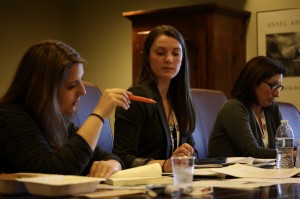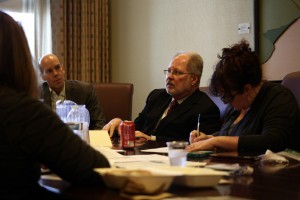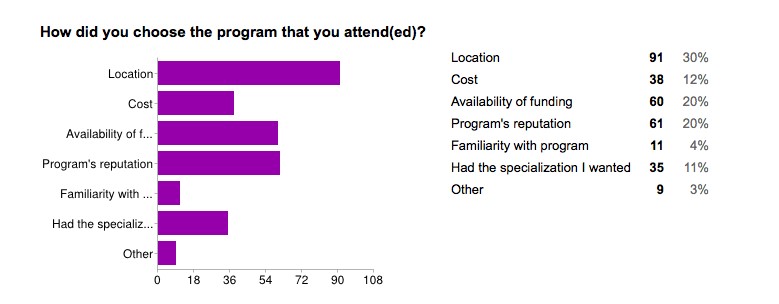Choosing a public history program survey results
28 May 2014 – editors

The New Professional and Graduate Student Committee discusses the Public History Navigator in Monterey. Photo credit: NCPH
We asked and you shared! One hundred sixty-six respondents participated in the NCPH New Professional and Graduate Student Committee survey, offering their input for creating a consumer’s guide to public history. Now officially titled “Public History Navigator: How to Choose and Thrive in a Graduate Program,” this exciting project will provide one tool to address shared concerns about the “perfect storm”–the phrase National Council for Public History Past President Bob Weyeneth used to describe the public history training and jobs crisis.
The responses provide a compelling look not only into graduate program expectations and experiences but also the morale of future and current public history professionals. Before we move forward with creating the guide, which will help folks know “how to choose and thrive in a public history graduate program,” we wanted to share a summary of the survey results.

The New Professional and Graduate Student Committee discusses the Public History Navigator in Monterey. Courtesy NCPH.
There were three types of questions: demographic questions to see who answered the survey, focused questions to help us understand the types of programs people attended or are attending, and open questions so that you could share your experiences and advice with others.
Demographics
Seventy-seven percent of surveyed respondents were between 23 and 35 years old, 75 percent were female, and 94 percent lived in the United States. Master’s graduate students made up 30 percent of respondents, while 28 percent were new professionals employed in a public history related field. Fifty-four percent of all respondents had or were in the process of receiving formal training in a public history graduate program. A total of 28 percent had or were in the process of receiving either museum studies or historic preservation graduate degrees/concentrations.
Focused Questions
- Location played the biggest role in choosing a graduate program, while availability of funding and a program’s reputation tied for second as factors influencing people’s choices.
- Only 17 percent of respondents’ career goals remained the same from when they entered their programs.
- Forty-seven percent of students held an internship in graduate school and of that number 45 percent were unpaid. Only 28 percent completed a thesis requirement.
- Tuition waivers and stipends proved almost equal as the two most common types of program funding. Only 16 percent of respondents did not receive any funding.
- A majority of respondents wished they better understood the current job market before entering their graduate program. People wished they had known about rates of job placements, entry-level salaries, and the importance of gaining practical experience right away through internships and volunteering.
- Hands-on experience from internships, including oral history, preservation, archives, and exhibits, proved to be the most useful skills and experiences gained through graduate school. Respondents’ answers also highlighted how their programs developed opportunities to form a professional network; increased research, writing, and critical thinking skills; provided experience in project management; and offered chances to work with local audiences and communities.
- Respondents believed that they should have gained greater knowledge of practical skills like grant writing, budgeting, and technology as opposed to theory. They desired more direction in career development including job applications, interviews, and salary negotiation.
- Despite these reservations, a majority answered that their program experience helped them to gain a realistic expectation of the current public history job market. On the other hand, many also expressed frustration and disappointment that challenges in finding gainful employment were not entirely recognized and/or communicated to them throughout their program.
- An overwhelming majority of respondents would “do it all again” and make the same program choice or would have chosen a different program but still attended graduate school. The leading reason respondents regretted their choice was due to overwhelming debt compared to low incomes.
These insights display collective frustrations and joys involved in gaining a graduate degree. Your answers to the survey questions show the committee what is most needed and wanted as we create the Public History Navigator and will help us produce a more effective and useful resource.
The NCPH New Professional and Graduate Committee aims to have this resource available this fall. We will announce the guide’s premiere here on History@Work, and you can follow our progress on Twitter via the hashtag #PHNavigator.
Please feel free to add any questions or comments about this work below. We thank everyone for their contribution to this ongoing dialogue!
~ NCPH New Professional and Graduate Student Committee






1 comment